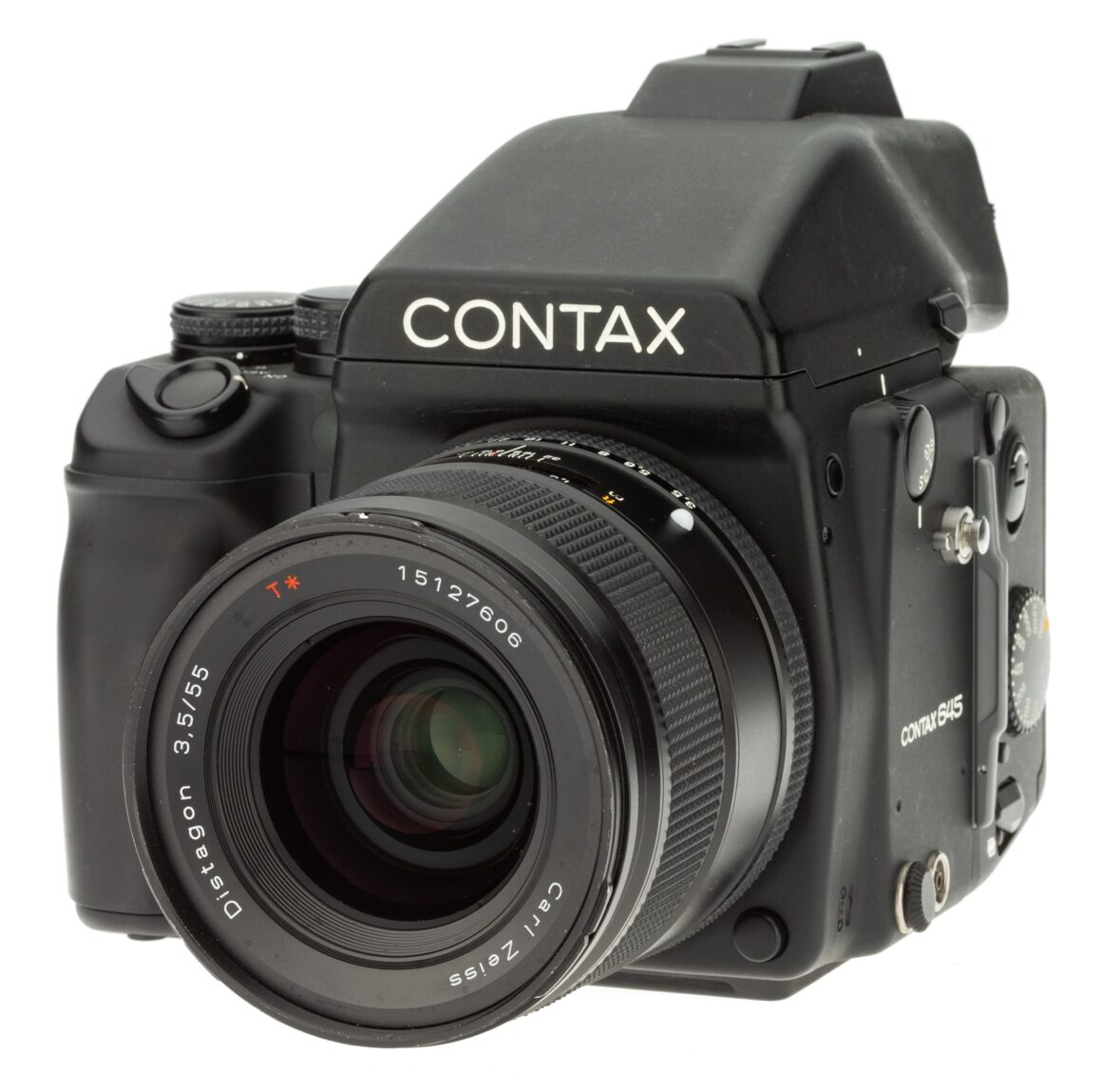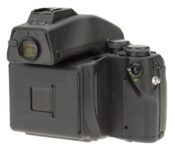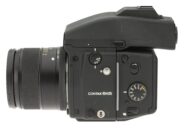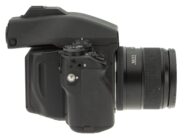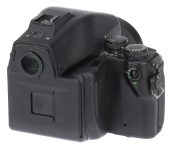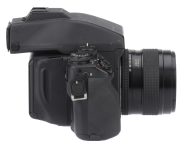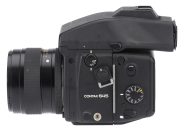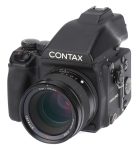Contax 645 AF
Medium format AF film SLR camera
Specification
| Production details: | |
| Announced: | February 1999 |
| System: | ● Contax 645 (1999) |
| Format: | |
| Maximum format: | Medium format 6x4.5 |
| Film type: | 120 roll film |
| 220 roll film | |
| Mount and Flange focal distance: | Contax 645 [64mm] |
| Shutter: | |
| Type: | Focal-plane |
| Model: | Electronically controlled |
| Speeds: | 8 - 1/4000 + B |
| Exposure: | |
| Exposure metering: | Through-the-lens (TTL), open-aperture |
| Exposure modes: | Aperture-priority Auto |
| Shutter-priority Auto | |
| Manual | |
| Physical characteristics: | |
| Weight: | 645g |
| Dimensions: | 141x99x73mm |
Manufacturer description #1
The photographer’s demand for high quality tools is always met by CONTAX. As a result, CONTAX introduces the world’s finest Auto Focus 645 format SLR camera system. The CONTAX 645 is a complete auto focus medium format system that has been designed to deliver the highest quality photographic results. As one would expect, the same attention to detail and high quality that is applied to the 35mm CONTAX products is extended into this new medium format camera system.
The CONTAX 645 lens system is composed of six outstanding Carl Zeiss T* Auto Focus lenses including the Distagon T* 35mm f3.5 (21mm lens in 35mm), Distagon T* 45mm f2.8 (28mm lens in 35mm), Planar T* 80mm f2 (50mm lens in 35mm), Apo-Makro Planar T* 120mm f4 (75mm lens in 35mm), Sonnar T* 140mm f2.8 (87mm in 35mm), Sonnar T* 210mm f4 (131mm lens in 35mm).
Auto focusing on the CONTAX 645 is a phase difference detection (passive) system. The user can select either Single Auto Focus or Continuous Auto Focus according to the needs of the photographer. A seamless transition from AF to manual focus is accomplished by the photographer simply taking control of the lens. When the photographer takes over the focusing system by beginning to focus, the AF system releases immediately transferring control to the user. There is no AF/MF switch required on the CONTAX 645. The CONTAX 645 is the most advanced medium format body ever developed to match the high quality of Carl Zeiss T* optics.
A new concept in internal camera control has been implemented in the CONTAX 645. There is a micro-processor on-board each major system component for solid-state internal communication over a distributed computer network. No mechanical linkages are present. This allows accurate and precisely adjustable communication between all system components at the speed of an electron.
The CONTAX 645 incorporates a motor drive which offers the fastest film advance system available in the medium format industry. The 2.5 frames per second drive is built-in and is standard equipment on the CONTAX 645. The camera also provides interchangeable backs with 16 exposures on each roll of 120 film and 33 frames on a roll of 220. Auto advance to the first frame is standard, as is mid-roll advance to end of roll. CONTAX has also applied its industry leading technology to integrate a Real Time Vacuum system that pulls the film down to the pressure plate before every exposure. This is a system pioneered and proven effective in the CONTAX RTS III. This system can operate because there is no paper backing interfering on 220 film.
Data Back imprinting is incorporated into both the 120 and 220 film backs. This system offers imprinting of f-stop, shutter speed, exposure compensation, exposure mode and lens information.
Also included as standard equipment is a detachable eye-level AE Prism that provides bright and even illumination over the entire screen. The AE functions include Aperture Priority (AV), Shutter priority (TV) and Manual metering. These AE functions are also extended to use on the optional waist-level finder, since the SPD exposure sensor is located in the camera body. The AE Prism also includes spot metering, center-weighted average metering and the famous TTL Pre-Flash Metering system that was originally introduced on the CONTAX RTS III. Automatic Bracketing Control (A.B.C.) is included with a choice of 0.5 or 1.0 EV selection. The user can select from three bright, interchangeable focusing screens. The standard screen supplied with the CONTAX 645 is an unencumbered matte type screen. Also available is the microprism collar surrounding a split image screen as well as a grid screen. Each finder provides a 95% field of view. A built-in diopter selector offers viewfinder diopters from -2d to +1d, and this system is extendible with use of the FM diopters found in the 35mm camera accessories.
Viewfinder information is complete in the CONTAX 645. Aperture display, f-stop, exposure warning, flash indication (including pre-flash TTL metering), exposure compensation (+/- 2 EV), exposure counter and AF confirmation are all visible in the viewfinder.
Shutters are key to the success of any medium format camera. They are necessarily large and often slow. CONTAX changes all that by offering the fastest medium format focal plane shutter in the world at 1/4000 second top shutter speed and the fastest X sync at 1/125 second. This shutter out-performs many 35mm cameras. The CONTAX 645 is also lens/shutter capable. The photographer can look forward to introductions soon of several lens/shutter lenses for the CONTAX 645.
The TTL flash system is the same as the Extended TLA Flash system as used on the CONTAX RX, AX and Aria. That is, the CONTAX 645 offers the five-pin flash connection that mates with the CONTAX TLA360 flash. This system allows flash ratios to be set from the flash and it also displays the set f-stop on the flash LCD.
The design and execution of the CONTAX 645 represents a landmark step in the evolution of medium format cameras. As we learned with our 35mm camera system, the best approach to leading the pack in camera design is to combine state-of-the-art lensmaking with space age electronics.
The CONTAX 645 and Carl Zeiss T* lenses come supplied with a USA Limited Three Year Warranty. This camera and the system will be available from January, 1999. The price is as yet, undetermined. For retail locations, consumers can call CONTAX North America at 1-800-526-0266. CONTAX North America, is a division of Kyocera Electronics, Inc., which manufactures and markets a wide array of photographic equipment including SLR’s, sophisticated point and shoot cameras and accessories.
Manufacturer description #2
Born with a reverence for the traditional, yet advanced beyond your dreams. The Contax 645 is poised for the 21st century.
This new century will bring many challenges and the 645 is ready for any of them. Autofocus backed by a precision manual focus system provides the ultimate in focusing flexibility. Film flatness problems are addressed for the first time in any medium format camera through the development of a Real Time Vacuum system. Of course, the unrivaled Carl Zeiss T* lenses are the stars of the system. These lenses offer unmatched resolution and distortion control while T* insures that contrast and color are unrivaled. In short, the CONTAX 645 represents the highest expression of technology in medium format cameras today and into the future.
A MEMORY GIVES MEANING TO THE LIGHT.
A newly developed autofocus system and dual focus mechanism make it easy to control autofocus and manual focus.
Giving meaning to the capture of light in an image depends upon the sensitivity of the photographer. Based upon the premise that "the main element involved in creation of the photograph is the photographer", the Contax 645 offers a newly developed focusing system. Dual Focus controls autofocus and manual focus to meet the expectations of the photographer. This Dual Focus system allows the AF system to assist the manual system and the manual system to assist the autofocus system.
Without moving your eye from the viewfinder, the 645 may be changed from AF to manual and visa-versa. Autofocus uses a central TIL area sensor composed of four horizontal and two vertical lines, composing an array of 1/5-inch, 250,000 element CCD. Superior range finding accuracy is obtained.
MULTICOLORED LIGHT CAN PROVIDE STUNNING PHOTOGRAPHS.
A high-speed shutter coupled wit the high performance of Carl Zeiss T* lenses brings great flexibility to the photographer.
A larger film size leads to a larger shutter. Consequently, the fastest shutter speed of a conventional medium format camera has difficulty in achieving speeds as fast as those of a 35mm camera. The Contax 645 dramatically expands the range for taking photographs with medium format cameras.
The newly developed high-speed focal plane shutter is the most advanced shutter in this class. The Contax 645 achieves a high shutter speed of 1/4000 second and the fastest flash sync speed of 1/125 second. Higher shutter speeds allow the photographer greater freedom in selecting exposure.
VACUUM INSERT PROVIDES INCREASED RESOLUTION
The real-time vacuum system enhances film flatness, the biggest problem faced by medium format cameras
The biggest problem found in medium format cameras was film flatness. Film flatness becomes more difficult as the film area is increased. In particular, the open aperture of a fast lens produces an extremely shallow depth of focus. The slightest unevenness in the film degrades focus appreciably. As a result, conventional medium format photographers tend to produce stopped-down photographs. The Contax 645 provides a real-time vacuum system, highly valued in the RTS III, in the 6 x 4.5 size format. A striking improvement in film flatness can be achieved by installing the 220 vacuum film insert. Wide open apertures may be used with confidence.
LIGHT IS MANIPULATED AS DESIRED.
Light metering system and exposure modes to faithfully reflect the intent of the photographer
The Contax 645 employs two types of light metering, center-weighted average metering which has excellent characteristics for general photography and spot metering suited to small area exposure settings. When the AE prism finder is installed, center-weighted average metering or spot metering can be used. The spot metering system installed in the body of the Contax 645 makes spot metering available even when the waist-level finder is installed. The exposure modes are aperture-priority AE, shutter- priority AE, and manual exposure. Additionally, the automatic bracketing control (AB.C) mechanism for automatically correcting the exposure in three consecutive frames is installed. Rapid, reliable photography is possible even for subjects requiring difficult exposure settings.
Center-Weighted Average Metering
Center-weighted average metering is well suited to typical photographs in which the main subject is close to the center of the image. By designing the optimum sensitivity distribution the camera is easy to use and can adapt to various photographic conditions. The center-weighted average metering block (high precision aspherical lens + SPD element + IC) is located in the AE prism finder.
Spot Metering
Spot metering is effective when you want to express the exposure with more precision and creativity than in ordinary light. Spot metering takes place in an area having a 5.5mm diameter in the center of the focusing screen, and usually operates along with the AE lock mechanism. This method demonstrates the power of the photographer with regard to placement of specific tones in a composition.
A.B.C. Mechanism
By merely switching the AB.C lever, this mechanism can offer three exposure variations: standard, over, or under exposure. The selectable corrections are ±0.5 EV and ±1.0 EV. Each exposure mode, except flash photography, is influenced by the A.B.C mechanism, spot or center-weighted, drive mode, AE lock, and the exposure compensation system are all handled. Even under delicate exposure conditions, photography is possible without becoming absorbed in exposure control decisions.
INTEGRATED FLASH METERING SIMPLIFIES STUDIO FLASH FOR CONSISTENTLY ACCURATE RESULTS
Pre-flash TTL light metering enables high quality photography
Determining the exposure for flash photography is normally a complex process. The pre-flash TTL metering system tests the flash output before exposing the film. This system frees the photographer from unstable factors such as metering errors caused by differences in film reflectance. Because the Contax system flash can remember the amount of emitted light that was automatically adjusted, the exposure can be controlled within later aperture adjustments. This system not only applies to Contax system flashes, but to general-purpose and studio flash equipment as well.
MULTIPLE FINDER SYSTEM PROVIDES FLEXIBILITY
Finder system adapts to various photographic conditions and the objective of the photographer
The Contax 645 finder system can be adapted to match the objective of the photographer. The system provides two types of finders, the AE prism finder and waist-level finder. Three focusing screens are available, full matte (standard equipment), sectioned matte, and horizontal split-screen microprism.
THE EXPOSURE VALUE IS MEMORIZED
A photographic data memory function is provided.
Reference data is recorded outside the image frame of the film, including aperture, shutter speed, exposure compensation, exposure mode, lens used, and film type.
TTL LIGHT METERING
Flash auto setting greatly expands the range of flash photography
When a flash, such as the TLA360 is attached to the accessory shoe of the AE Prism and switched to the Auto-set position, the film sensitivity data, aperture data, and lens focal length data are shared with the flash and shown on the display panel on the back of the flash. The illumination angle is automatically adjusted to match the focal length of the lens. In addition to exposure compensation in the body, the flash exposure can be adjusted for a more flexible flash fill. The Auto-set function improves communication between camera and the flash.
Manufacturer description #3
Lens mount: Contax 645 mount
Shutter system: Electronically controlled focal-plane shutter
Shutter speed: Auto - 32 seconds to 1/4000 second; Manual - 8 seconds to 1/ 4000 second, X (1 / 125 second); Bulb, mechanical bulb
Sync contact: X contact (synchronized at 1/125 second or lower). With direct X contact and sync terminal
Self-timer: Electronic, operating time switches between 2 and 10 seconds, can be canceled while running
Shutter release: Electronic release and dedicated release socket
Exposure control: 1. Aperture-priority auto exposure; 2. Shutter-priority auto exposure; 3. Manual exposure; 4. TTL auto flash; 5. Manual flash
Light metering - Standard TTL Metering: Center-weighted average metering, spot metering, pre-flash TTL light metering
Continuous light metering range (ISO 100, F2): Center-weighted average metering - EV 1 to 21; Spot metering - EV 3 to 18.
Film speed range: ISO 6 to 6400, Automatic using bar code system
AE lock: AE and focus lock
Exposure compensation: +2 EV to -2 EV (can be set in steps of 1/ 3 EV)
A.B.C. mechanism: 3-frame continuous exposure compensation, exposure compensation ranges of ±0.5 EV and ±1 EV
Flash link light adjusting: TTL direct light adjusting
Flash sync: The shutter speed is switched automatically when the dedicated flash is done charging.
Flash auto set function: This can be combined with the flash equipped with Contax's auto set function.
Shutter curtain sync: Can be combined with Contax's flash having a shutter curtain sync
Focus adjustment and range finding: Manual focus and auto focus (TTL phase difference detection) Distance detection range: EV 1 to 18 (ISO 100)
Finder: Interchangeable finder, AE prism finder. Field of view - 95%. Magnification - 0.8 times (long eye point) (for standard 80mm lens at infinity and -10 visual angle). Built-in visibility correction mechanism, +10 to -20 correction range
Focusing screen: Interchangeable screen. The full matte screen is standard.
Internal finder display: Battery warning mark, frame counter, time remaining on self-timer, A.B.C. indication/End of film indication/Custom function indication, metering mark, flash ready mark, focus mark, aperture, shutter speed, exposure meter
Film back: Interchangeable film backs. 120/220 film insert MFB-1A. 220 vacuum film insert MFB-1B
Film loading: Semi-automatic loading by matching the start position mark (with fast forward function until the first frame) and easy load system
Film winding: Automatic winding by a built-in motor (fastest speed is about 1.6 frames/second)
Drive mode: Single frame, continuous, self-timer (2 or 10 seconds)
Frame counter: Additive, automatic reset
Multiple exposures: Possible
Mirror up: Possible
Accessory shoe: Direct X contact (with TLA flash linked contact)
Data recording: Can record photography data outside of the image plane. Recorded contents - aperture, shutter speed, exposure compensation, exposure mode, name of lens used, type of film
Power supply: one 6 V lithium battery (2CR5)
Battery check: automatic check, displayed inside the finder
Other features: aperture button, external power supply socket
